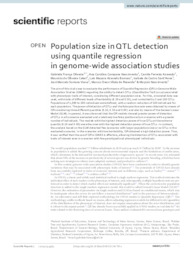Population size in QTL detection using quantile regression in genome?wide association studies.
Population size in QTL detection using quantile regression in genome?wide association studies.
Author(s): OLIVEIRA, G. F.; NASCIMENTO, A. C. C.; AZEVEDO, C. F.; CELERI, M. de O.; BARROSO, L. M. A.; SANT’ANNA, I. de C.; VIANA, J. M. S.; RESENDE, M. D. V. de; NASCIMENTO, M.
Summary: The aim of this study was to evaluate the performance of Quantile Regression (QR) in Genome-Wide Association Studies (GWAS) regarding the ability to detect QTLs (Quantitative Trait Locus) associated with phenotypic traits of interest, considering different population sizes. For this, simulated data was used, with traits of different levels of heritability (0.30 and 0.50), and controlled by 3 and 100 QTLs. Populations of 1,000 to 200 individuals were defined, with a random reduction of 100 individuals for each population. The power of detection of QTLs and the false positive rate were obtained by means of QR considering three different quantiles (0.10, 0.50 and 0.90) and also by means of the General Linear Model (GLM). In general, it was observed that the QR models showed greater power of detection of QTLs in all scenarios evaluated and a relatively low false positive rate in scenarios with a greater number of individuals. The models with the highest detection power of true QTLs at the extreme quantils (0.10 and 0.90) were the ones with the highest detection power of true QTLs. In contrast, the analysis based on the GLM detected few (scenarios with larger population size) or no QTLs in the evaluated scenarios. In the scenarios with low heritability, QR obtained a high detection power. Thus, it was verified that the use of QR in GWAS is effective, allowing the detection of QTLs associated with traits of interest even in scenarios with few genotyped and phenotyped individuals.
Publication year: 2023
Types of publication: Journal article
Unit: Embrapa Coffee
Observation
Some of Embrapa's publications are published as ePub files. To read them, use or download one of the following free software options to your computer or mobile device. Android: Google Play Books; IOS: iBooks; Windows and Linux: Calibre.
Access other publications
Access the Agricultural Research Database (BDPA) to consult Embrapa's full library collection and records.
Visit Embrapa Bookstore to purchase books and other publications sold by Embrapa.

